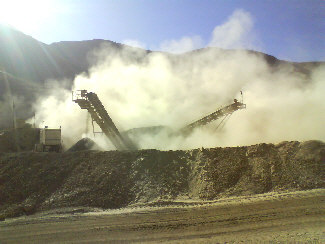Dust Including Silica Dust
Controlling DustDust is produced in the quarrying process while it is being blasted, crushed, screened, transported and stored. There are three ways that you can manage dust: 1. Contain it, 2. collect it, or 3. suppress it The Pareto principle (or 80-20 rule) applies to quarry dust generation. "Eighty percent of the dust in a given quarry is generated by 20% of the sources |
 |
Dust levels can be reduced at drilling processes by using water when drilling, good blast design can produce better fragmentation reducing the amount of crushing required. Dust production at haul roads can be reduced by suppressing the dust on the floor by the use of water tankers and good surfacing of haul roads also significantly reduces dust make. Good housekeeping in the cabs of vehicles and regular changing of filters on air conditioning units in vehicles significantly reduce driver exposure. Crusher operators should be situated in positively pressured dust proof cabs and crushing activities can, in some circumstances, be enclosed with local extraction systems removing the dust at source. Good conveyor maintenance also significantly reduces airborne dust and this can be improved further by using water suppression at transfer points and by good chute design.
www.safequarry.com have a video on their you tube channel that comprises of a series of quarry-based activities, this video features an animated quarryman who does everything wrong. The exploits of this hapless character are interspersed with high quality real-life
Dust Monitoring
Dust monitoring is carried out either through the use of personal samplers that can be set up to assess the exposure of employees to dust that is created from any operations that are being carried out during the sampling period or by having fixed monitors at locations within the quarry that measure the dust levels at that location.
In order to control exposure and protect employees it is important to discover the level of exposure to ensure that adequate control measures are introduced. The assumption of compliance is not enough; measures are required to prove that the risks have been adequately assessed.
Stone Dust not Containing Silica
Dusts can be classified as either total inhalable dust or respirable dust. The different categories relate to the size of the dust particles in the atmosphere with respirable dust being finer and thus able to penetrate further into the lungs where it remains. The main health effects associated with dust exposure are bronchitis, asthma and in extreme cases cancer.
Dust Containing Silica
A major health risk encountered by people working in the quarrying industry is exposure to fine respirable dust which contains silica. Silica is found in the majority of rocks, sands and clays and therefore workers within the quarrying industry and masonry industry are particularly susceptible. Silica dust exposure to workers can arise from the quarrying of stone, crushing, screening and sizing of the product, recirculation of dust within the cabs of vehicles and also from small scale working such as cutting and processing of kerbstones, block paving, bricks, flags and tiles and cement production. Workers are at risk from fine airborne particles, entering into the respiratory tract. However, these small particles are often not visible to the naked eye and therefore may not be an obvious exposure risk to workers. Exposure over a number of years can lead to the development of the condition known as silicosis. This is a form of scar tissue in the gas exchange region of the lungs that leads to difficulties in oxygen uptake into the bloodstream. Furthermore new evidence suggests that long term exposure to silica can increase the risk of the development of lung cancer.

